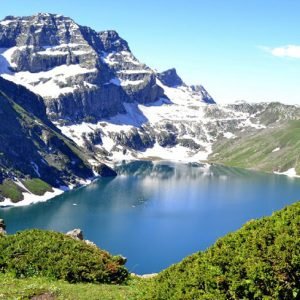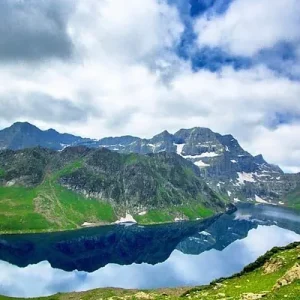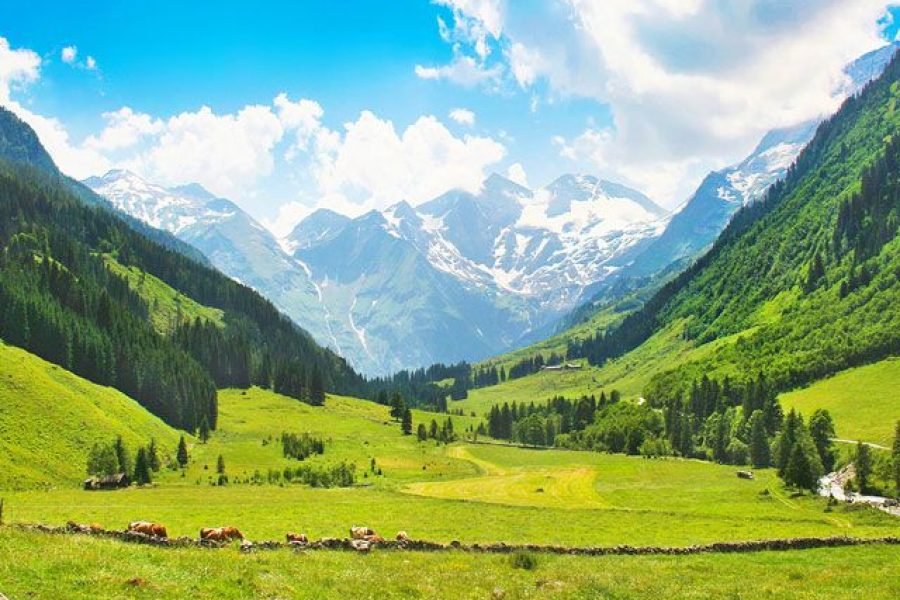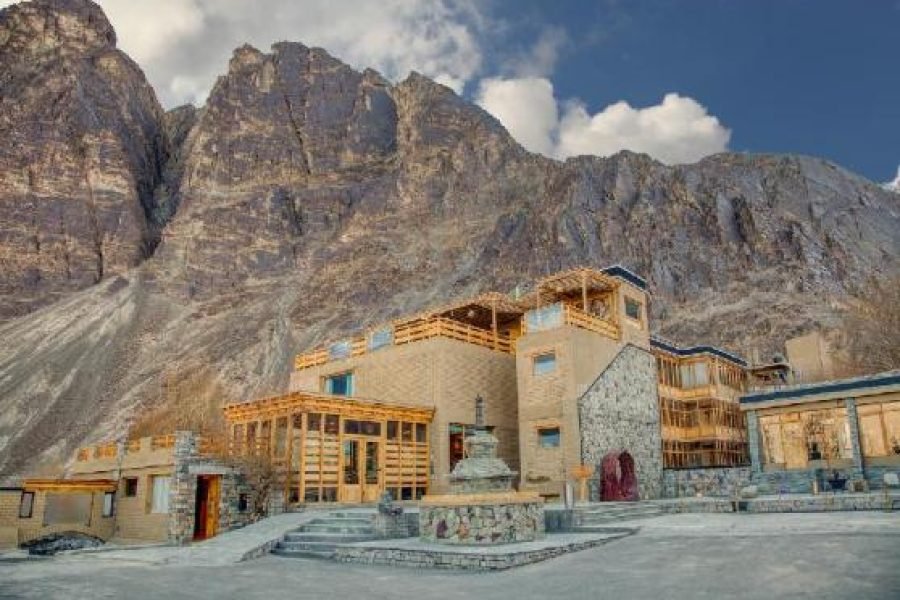Tarsar Marsar : Nature's Perfect Reflection





Table of Contents
Toggle1. Introduction
Tarsar Marsar Lake, within Jammu and Kashmir, is set amidst some beautiful landscapes, which are nothing but virgin heavens for nature lovers and adventure enthusiasts. This guide shall take a closer look at the Tarsar Marsar Lake and describe its geography, history, the trek details, flora and fauna, cultural importance, and a few practical tips that must be kept in mind while visiting the place. Whether it is planning a trek or simply knowing more about this glorious destination, this guide covers everything that makes Tarsar Marsar Lake worth a visit.
2. Geography and Location
Tarsar Marsar Lake is located in the Anantnag district of Jammu and Kashmir, India. These twin lakes form part of the bigger Kolahoi Glacier system and are situated at an elevation of about 3,800 meters or 12,500 feet above sea level. The topography consists of rugged terrain, alpine meadows, and dense forests that present a kaleidoscopic backdrop-alluring throughout the year.
These lakes are comparatively far-flung, lying nestled amidst folds of emerald in the Himalayas. The much bigger Tarsar Lake usually wears strikingly blue waters and an environment of serenity, while Marsar is somewhat above the Tarsar and represents a more tranquil and remote experience.
3. History and Significance
Tarsar Marsar Lake embodies in its entity the cultural and spiritual heritage of the region. In the absence of definite historical record about when these lakes were formed, they form part of the local folklore and tradition. The lakes are often associated with local myths and legends; some believe the lakes have divine significance on account of the pristine nature and remoteness of location.
This area of Tarsar Marsar is very important from the ecological point of view. The reason being straightforward, a number of rare and endangered species come here, that makes the area important w.r.t conservation and environmental studies.
4. The Route of Tarsar Marsar Trek
a. Abstract of the Trek
The Tarsar Marsar trek encompasses an exciting journey through some of the most beautiful landscapes that the Himalayas have to offer. Most of the regular Himalayan treks reach in the range of about 45-50 kilometers and take approximately around 7 to 9 days, depending on the itinerary one is following and the capability that day.
Day 1: Srinagar to Aru
It starts from Srinagar, from where the trekkers take a road drive to reach a small village named Aru, which serves as a base camp for the Kolahoi Glacier Trek. The journey gives an idea about the scenic beauty it would present in the days to come.
Day 2: Aru to Lidderwat
From Aru, the trekking starts to Lidderwat, a beautiful meadow and a stunning viewpoint of the surrounding peaks. It is comparatively easy and can help the trekkers get used to the altitude.
Day 3: Lidderwat to Tarsar Lake
Today, the trek will take the route through lush forests and meadows before finally reaching Tarsar Lake. It includes a gradual ascent today, but the view from Tarsar Lake in the form of blue waters makes it considerably worth the effort.
Day 4: Tarsar Lake to Marsar Lake
Today, trekkers go around alpine meadows and rocky terrain to reach Marsar Lake. The trail is dotted with breathtaking views of the surrounding peaks and valleys.
Day 5: Marsar Lake to Homwas
From Marsar Lake, the trek moves to Homwas by crossing different panoramic landscapes. On this day, one has to descend from the lake and cross a number of streams.
Day 6: Homwas to Aru
For return, the trekkers go back to Aru and start with the same route through lush meadows and forest areas.
Day 7: Aru to Srinagar
The return trip to Srinagar is made by driving, after which one can rest and see the places of interest in the city.
b. Difficulty Level
The difficulty level of the Tarsar Marsar trek ranges between moderate and challenging. Trekkers must be prepared for weather conditions that change, varying temperatures, and steep ascents. Proper acclimatization, physical fitness, and suitable gear for trekking will ensure a successful expedition.
5. Flora and Fauna
a. Flora
A variety of flora are made up of alpine meadows, lush forests, and high-altitude vegetation across the region surrounding the Tarsar Marsar Lake. Some of the key species of plants include:
i. Rhododendron: These flowers are in vibrant colors.
ii. Deodar: Evergreen tall coniferous trees providing dense forest cover.
iii. Blue Poppy: A rare and beautiful type of flora found at higher altitudes.
iv. Wild flowers: Many species of wild flowers add color to the landscape during the trekking season.
b. Fauna
The fauna of Tarsar Marsar includes several rare and endangered species. The notable wildlife includes:
i. Himalayan Brown Bear: Elusive species found in the remote areas of the region.
ii. Musk Deer: Known for their distinguishing musk glands and elusive nature.
iii. Himalayan Monal: This is known as State bird and is identified essentially by its striking plumage.
iv. Snow Leopard: Hardly sighted, these mighty predators of prey are found at higher altitudes.
6. Cultural Significance
The Tarsar Marsar Lake possesses cultural significance for the host communities due to the presence of a variety of tribes like Gujjars and Bakarwals, attached with traditional ties to land and resources. These lakes often relate to the local folklore and spiritual beliefs, while their pristine beauty is associated with regional songs and stories.
The trek through Tarsar Marsar shows the traditional way of life of the locals, their pastoral practices, and their seasonal migrations. Interacting with the locals enhances one’s experience of the cultural and spiritual significance of the region.
7. Practical Information
a. Best Time to Visit
The period between late June to early September is considered as the best time to visit Tarsar Marsar Lake. During this time period, the weather remains pretty stable and the trekking routes are clear of snow. Temperature remains congenial with breathtakingly beautiful views during summers, which is quite ideal for trekking.
b. Permissions and Regulations
Visiting Tarsar Marsar Lake requires permits, which are to be issued from local authorities. In this regard, the Tourism Department, J and K is best recommended to make inquiries for the latest regulations and permit requirements before embarking on a trip.
c. Packing List
Following are the essentials to be carried along on the trek:
i. Trekking Boots: Strong and comfortable shoes for rough grounds.
ii. Warm Clothing: Multiple layers for ever-changing temperatures.
iii. Sleeping Bag: Appropriate for chilly nights at high altitudes.
iv. First-aid kit: with basic medication on an emergency basis
v. Trekking poles: for support on uneven and slippery paths
vi. Water bottles: Hydration is very important, especially at a high altitude.
vii. Sunscreen and sunglasses: to protect against the UV rays of the sun
d. Accommodations
Accommodation facilities are available at Aru and Lidderwat, having basic campsites and guesthouses. Local tent accommodations by trekking agencies would be availed once on the trek. Prior bookings regarding these two facilities are advantageous.
e. Safety Tips
i. Acclimatization: Give your body some time to acclimatize and avoid acute mountain sickness.
ii. Weather Conditions: Be prepared for potential weather changes and carry appropriate clothing according to the forecast.
iii. Guides and Porters: Hiring experienced guides and porters could increase safety and comfort during the trekking.
iv. Environmental Conservation: Utilizing Leave No Trace principles can help protect the natural beauty of the area.
8. Conclusion
Tarsar Marsar Lake combines the variety of nature, culture, and some element of adventure in its own way. This magical land walk will enable you to view the fresh, untouched sights of the Himalayas. The place is known for crystal clear lakes, varieties in flora and fauna, as well as a rich cultural heritage. Tarsar Marsar Lake is one spot that surely contains memories for any particular trekker who goes there. Be you an avid trekker or a nature lover, Tarsar Marsar is just a destination not to be missed-one that epitomizes the serenity of the Himalayan wilderness.
How to book a trip to Tarsar Marsar Lake, India with Charzan Holidays?
For a seamless and exceptional booking experience, contact Charzan Holidays at reservations@charzan.in or call us at +919622224473
Frequently Asked Questions
1. What are Tarsar and Marsar Lakes? | |
| Tarsar and Marsar are two stunning alpine lakes located in the Kashmir Valley of India, known for their breathtaking scenery and unique ecosystems. | |
2. Where are Tarsar and Marsar Lakes located? | |
| These lakes are situated in the Anantnag district of Jammu and Kashmir, approximately 50 kilometers from Srinagar. | |
3. How can I reach Tarsar Marsar Lakes? | |
| The lakes can be accessed via a trekking route that typically begins from Aru Valley, with a trek of around 30 kilometers required to reach Tarsar Lake. | |
4. What is the best time to visit Tarsar Marsar Lakes? | |
| The best time to visit is from June to September, when the weather is mild and the lakes are free from snow, making trekking easier. | |
5. Are there any accommodations available near Tarsar Marsar Lakes? | |
| There are no permanent accommodations directly at the lakes, but trekkers can camp in designated areas or stay in guesthouses in nearby Aru Valley. | |
6. What activities can I do at Tarsar Marsar Lakes? | |
| Visitors can enjoy trekking, camping, photography, bird watching, and exploring the surrounding meadows and landscapes. | |
7. Is camping allowed at Tarsar Marsar Lakes? | |
| Yes, camping is allowed in designated areas near the lakes, and it is a popular option for trekkers looking to immerse themselves in nature. | |
8. What wildlife can be found around Tarsar Marsar Lakes? | |
| The area is home to diverse wildlife, including various bird species, Himalayan black bears, and other alpine fauna. | |
9. Can I go fishing in Tarsar Marsar Lakes? | |
| Fishing is generally not permitted in Tarsar and Marsar Lakes due to conservation efforts and the need to protect the ecosystem. | |
10. Is it safe to trek to Tarsar Marsar Lakes? | |
| Trekking to Tarsar Marsar Lakes is generally safe, but it’s advisable to be physically prepared, check weather conditions, and consider hiring a local guide. | |
11. What is the elevation of Tarsar Lake? | |
| Tarsar Lake is situated at an elevation of approximately 3,800 meters (12,467 feet) above sea level. | |
12. What is the elevation of Marsar Lake? | |
| Marsar Lake is slightly higher, located at an elevation of around 4,150 meters (13,615 feet) above sea level. | |
13. Are there any environmental concerns to consider while visiting? | |
| Yes, visitors should practice eco-friendly tourism by not littering, respecting local wildlife, and following guidelines to preserve the natural environment. | |
14. What should I pack for a trip to Tarsar Marsar Lakes? | |
| Essential items include warm clothing, sturdy trekking shoes, a first-aid kit, water, snacks, camping gear, and a camera for capturing the stunning scenery. | |
15. Are there guided tours available for Tarsar Marsar Lakes? | |
| Yes, several local tour operators offer guided treks to Tarsar Marsar Lakes, providing insights into the region’s ecology and culture. |









0 Comment